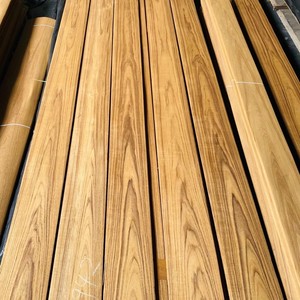
Hot Sale Natural Solid Wood Veneer 0.45mm 0.6mm Teak Vaneer Oak Veneer Rolls Skateboard Maple Veneer

Wholesale Natural Teak Wood Veneer 0.2mm 0.3mm 0.5mm 1mm 2mm 3mm Natural Plain Cut Burma Teak Veneers






















Burma teak veneer stands as a prominent choice for a variety of applications, offering the classic beauty of teak with a more accessible approach. This veneer is a thin slice of Burma teak wood, a material known for its durability and aesthetic appeal. It serves as an economical alternative to solid wood, particularly in large-scale or commercial projects where the use of solid teak may be impractical.
The versatility of Burma teak veneer is evident in its range of types, each suited to different applications. Burma teak plywood is a common form, combining the beauty of teak with the strength of plywood, ideal for furniture and cabinetry. For those seeking a lighter option, Burma teak wood laminate provides a flexible and easy-to-use surface for various interior decorations and fixtures.
One of the inherent features of Burma teak wood veneer is its adaptability. Unlike solid wood, it can be applied to curved surfaces, enhancing design possibilities. Additionally, its thinness allows for translucency, making it a perfect material for light-diffusing elements such as lamp shades. The customization potential of laid up veneer is significant, allowing for precise tailoring to specific design requirements.
The material composition of Burma teak veneer contributes to its durability. The natural oils in teak provide resistance to pests and decay, extending the lifespan of the products made with it. For environments where stability is crucial, backed wood veneer is an excellent option, as its stable backing material minimizes the risk of warping.
Sustainability is a key factor in material selection, and Burma teak veneer offers an eco-friendlier alternative to solid wood. The use of veneer maximizes the yield from a single tree, reducing the environmental impact. Moreover, laminated veneer often comes from faster-growing species, contributing to more sustainable forestry practices.
Selecting the right Burma teak veneer involves considering the specific needs of a project. Factors such as the intended application, desired aesthetics, and environmental conditions play a crucial role in the decision-making process. While Alibaba.com does not endorse or guarantee the products, the platform facilitates access to a diverse range of veneer options to meet various project requirements.